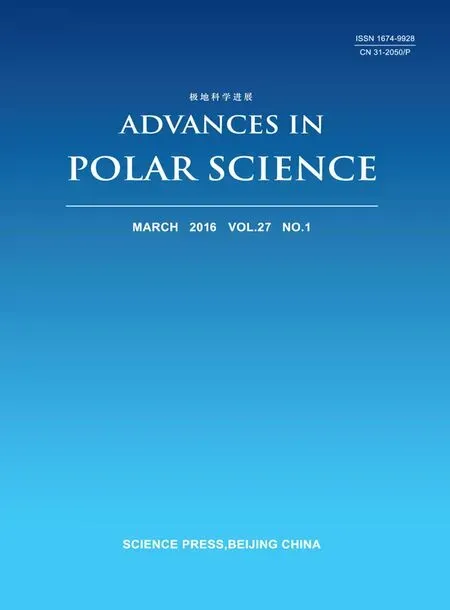Meteorite classification for building the Chinese Antarctic Meteorite Depository—Introduction of the classification of 500 Grove Mountains meteorites
2016-02-01XIAZhipengZHANGJieMIAOBingkuiOURonglinXIELanfangYANGRuiJINGYuan
XIA Zhipeng, ZHANG Jie, MIAO Bingkui, OU Ronglin,XIE Lanfang, YANG Rui & JING Yuan
1 Key Laboratory of Geological Fluid and Geological Process at Universities of Guangxi Province, Guilin 541004, China;
2 Guangxi Scientific Experiment Center of Mining, Metallurgy and Environment, Guilin University of Technology, Guilin 541004, China;
3 Guangxi Key Laboratory of Hidden Metallic Ore Deposits Exploration, Guilin University of Technology, Guilin 541004,China;
4 SOA Key Laboratory for Polar Science, Polar Research Institute of China, Shanghai 200136, China;
5 No.4 Gold Geological Detachment of the Chinese People’s Armed Police Force, Liaoyang 111000, China
1 Introduction
With the exception of samples brought to Earth by the Apollo program, lunar exploration vehicles and other asteroid missions, meteorites are the only extraterrestrial materials which can be analyzed directly in the laboratory. Meteorites are derived from asteroids and planetary bodies which formed at various times during the evolution of the solar system. As a result, meteorites have great scientific significance with respect to examining the origin and evolution history of the solar system.
One of the most prolific areas in which to find meteorites is Antarctica and, since 1998, China has undertaken seven meteorite survey programs in the Grove Mountains of Antarctica. The collection has been updated to a total of 12665 meteorite samples, which have provided a wealth of scientific resources for meteorite research and comparative planetary science[1-2]. All of these meteorites are stored at the Polar Research Institute of China (PRIC) in Shanghai. The arrangement of scientific resource data is the primary goal of the National Specimen Information Infrastructure (NSII)under the National Science and Technology Infrastructures Project, which is supported by the Ministry of Science and Technology and the Ministry of Finance of the People’s Republic of China. Therefore, to facilitate the storage and resource sharing of Antarctic meteorites in China, PRIC became involved with NSII in 2005 to set up the Chinese Antarctic Meteorite Depository (CAMD)[3].
To be of value in the CAMD and in the foundation of meteorite research, meteorite samples need not only to be identified and confirmed, but also to be classified appropriately. Since 2012, a total of 500 Antarctic meteorite samples have been classified. The purpose of this article is to introduce the results of the classification of 500 Antarctic meteorite samples, and also discuss the scientific significance and the role of classification played in constructing the CAMD.
2 Construction of the CAMD and Antarctic Meteorite classification
The first four meteorite discoveries in the Grove Mountains occurred during the 15th Chinese National Antarctic Research Expedition (CHINARE) in 1998–1999. A further six meteorite surveys in Grove Mountains were carried out in the 1999–2000, 2002–2003, 2005–2006, 2009–2010, 2013–2014 and 2015–2016 field seasons. The surveys discovered 28, 4448, 5354, 1618, 583, and 630 meteorites, respectively[4]. To both protect and share important scientific sample resources,sponsored by the NSII, the website of Resource-sharing Platform of Polar Samples (hereinafter referred to as BIRDS,http://birds.chinare.org.cn/) was established by PRIC in 2006 to digitize polar scientific samples resources.
The CAMD is one important part of BIRDS[5]and was primarily established to protect these significant scientificfinds, and also make them available for further scientific and social inquiry. The CAMD is owned by the Chinese Arctic and Antarctic Administration, managed by the PRIC, and professionally supervised by the Chinese Antarctic Meteorite Expert Committee. This committee is involved with making plans for and directing meteorite processing and classification.
After meteorite classification by the research group belonging to the Chinese Antarctic Meteorite Expert Committee, the basic information obtained is uploaded to BIRDS, from which polar researchers can obtain the scientific data. Through the BIRDS platform, researchers can browse meteorite samples and apply to undertake research with some of meteorites from the CAMD, after which the Chinese Antarctic Meteorite Expert Committee votes and approves the applications according to “Regulation of Chinese Antarctic Meteorites Management and Application”.
In 2000, the first four Grove Mountain meteorites were classified by Peking University and the Institute of Geology and Geophysics, Chinese Academy of Sciences. They were classified as three chondrites and one iron meteorite[6]. During 2001–2002, the 28 meteorite samples found by the 16th CHINARE were classified, followed in 2003 by classification of 51 representative meteorite samples of the 4448 meteorites collected during the 19th CHINARE[7-8]. After three meteorite classification studies, the Chinese classification procedure of Antarctic meteorites was set up.
With support from the NSII Project, classification of 2350 meteorite samples in the CAMD was completed during 2006–2008. As of 2011, the CAMD possessed 2429 classified Antarctic meteorites, with approved names from the Meteoritical Nomenclature Committee. Most of them are ordinary chondrites (90%), but there are other special meteorites that include two Martian meteorites, two HED meteorites (howardite–eucrite–diogenite), one acapulcoite,one winonaite, 10 ureilites, one enstatite chondrite, 20 carbonaceous chondrites, one iron meteorite, 11 mesosiderites,and one pallasite[4](Table 1). However, there are nearly 10000 unclassified meteorite samples in the CAMD and so, to best fulfil the resource sharing role of the CAMD, classification of these remaining Antarctic samples should be carried out as soon as possible.
3 Classification of 500 meteorites from Grove Mountains, Antarctica
3.1 Samples and the classification methods
Since 2012 there has been a continuous work flow of meteorite classification tasks, with classification of 60 samples in 2012, 90 samples in 2013, 150 samples in 2014, and 200 samples in 2015. A total of 500 samples were selected from the collection obtained during various seasons, including 350 meteorites from the 26th CHINARE(2009–2010) and 150 meteorites from the 30th CHINARE(2013–2014). The results of this classification are reported in this paper.
A meteorite name is initially based on international convention, such that it consists of (1) an abbreviation of geographical locality, (2) a two digit number of the year found, and the sequence in which it was found, e.g. GRV 13001 represents the first meteorite found from the Grove Mountains in 2013. In addition, GRV 09 samples are not chosen artificially and are taken by their original serial number, with the exception of a few of the large GRV 13 samples.
Polished sections were made from three iron meteorites,while standard thin sections (0.03 mm thick) were made from the rest of the meteorite samples. Their petrography was observed by optical microscopy and scanning electron microscopy (SEM) and mineral chemistry was analyzed by electron probe microanalyzer (EPMA). The chemical groups and petrographic types are determined according to Weisberg et al.[9]and Wang et al.[10], the degree of shock metamorphism by Stöfぼer et al.[11], and the terrestrial weathering degree by Wlotzka[12].
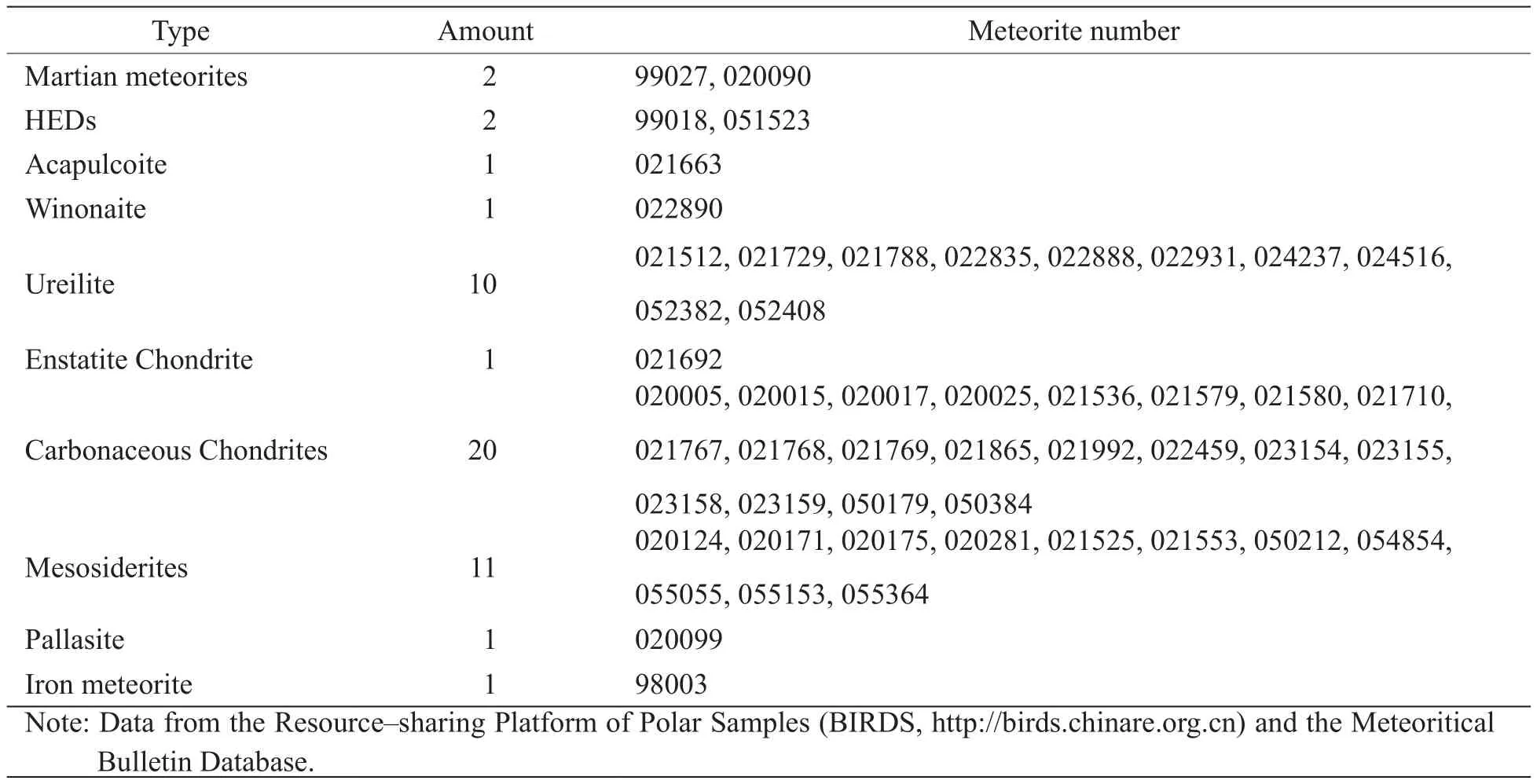
Table1 The list of the special meteorites from Grove Mountains, Antarctica
3.2 Results of the classification
Of the 500 field samples, the majority (488) are ordinary chondrites and 8 special meteorites (Table 2). Four samples were found to be of terrestrial origin, and therefore are not considered further as meteorites.

Table 2 Newly identified special meteorites in this study
3.2.1 Special meteorites
Over 75% of the surface of eucrite GRV 13001 (Figure 1a) is covered with a shiny black fusion crust, and the sample has a total mass of 1299.1 g. The interior is light gray in color,it contains many cracks that penetrate the interior and has a brecciated texture. The breccia contains a basaltic lithology,generally plagioclase-rich, with lath-like plagioclase typically 0.1–0.5 mm long, and some pyroxene laths up to 1.0 mm in length. A silica phase is also commonly present. A macroscopically dark gray, fine-grained clast (mean of 20–50 μm) shows an equilibrated metamorphic texture and also contains a silica phase. Accessory minerals include ilmenite,troilite and rare iron metal. The orthopyroxene compositions are Fs58.6-59.7Wo1.61-4.70(median Fs59.3Wo2.9, n=15) and the clinopyroxene compositions are Fs27.0-58.3Wo7.74-60.6(median Fs42.1Wo34.5, n=16). Plagioclase compositions are anorthitic(An92.7-96.1Or0.35-0.96, median An94.9Or0.64, n=8) and bulk electron microprobe analysis of the fusion crust reveals a composition of 22.4 wt.% FeO, 0.68 wt.% MnO and Fe/Mn=32.9.Isotopic data, determined by M.E. Sanborn and Q.-Z. Yin at the University of California, Davis, reveals that Δ17O=-0.25±0.02 and εCr=-0.33±0.09 (personal communication).
The carbonaceous chondrite GRV 13051 (Figure 1b)has no fusion crust and a total mass of 3.47 g. The angular sample is dark gray-black to black in color with a fine-grained matrix and abundant chondrules. The chondrules comprise about 30% of the sample by volume and are 50–300 μm in size. The main mineral found in the chondrules is olivine(Fa11-61.4, average Fa18.9), thus GRV 13051 is a CM2 carbonaceous chondrite. Many of the chondrules have igneous rims and the sample is littered with refractory inclusions about 0.3 mm in size set in a fine-grained matrix. Some hydrated minerals are also present in the matrix, such as serpentine.Other major minerals include pyroxene, and a small amount of Ni-rich troilite and chromite.
The enstatite chondrite GRV 13100 (Figure 1c) has a total mass of 0.68 g and a partial fusion crust. It is gray in color and contains abundant chondrules 0.1–1 mm in size(most are <0.5 mm). The silicate minerals in this meteorite include pyroxene, feldspar and some forsterite (Fa<1), while the opaque minerals include sulfides and traces of Fe-Ni metal. The sulfides include troilite, oldhamite, niningerite,daubreelite and perryite. The chemical composition of pyroxene is Fs0.17-6.5, with the majority being Fs0-1. The feldspar composition is An74.34±1.80Or1.14±0.21and the Fe-Ni metal has a Si content of 2.68–3.36 wt.%. This meteorite is an EH4 enstatite chondrite.
The ureilite GRV 090312 meteorite weighs 13.3 g(Figure 1d), and has the dimensions 3.1×2.2×2.0 cm. It has a typical ureilitic texture, with a mineral assemblage of olivine(>70 vol.%), pigeonite (~5 vol.%), carbon-rich interstitial material (>20 vol.%) and traces of iron metal. Its subhedral granulitic texture consists of olivine grains 0.5–2 mm in size, with traces of interstitial matrix of pyroxene and carbon polymorphs. The black carbon-rich matrix is found as thin irregular veins interstitially between silicates. In places, this carbon-rich matrix penetrates the interior of silicates along fissures and cleavages. The carbon polymorphs are mainly graphite with traces of diamond. Coarse-grained olivine shows reduction zonation with an FeO-rich core and MgO-rich rim; the core has a composition of Fa22.0±0.4(n=12)with 0.56–1.66 wt.% Cr2O3and 0.18–0.25 wt.% CaO . The pigeonite has a uniform composition of Fs19.7±0.4Wo4.3±1.1(n=13) with 1.14–2.41 wt.% Cr2O3.
The mesosiderite meteorite, GRV 090994 (Figure 1e),weighs 369.1 g and is irregular in shape. It has no fusion crust and is composed of silicates (65 vol.%) and Fe-Ni metal(35 vol.%) that are evenly distributed in the sample. The silicates are mainly composed of orthopyroxene (Fs27-33Wo2-5)with a low FeO/MnO ratio (21) and feldspar that is anorthitic(An77-82). The Fe-Ni metal consists of kamacite (4.71–6.22 wt.% Ni) and taenite (36.2–46.1 wt.% Ni).
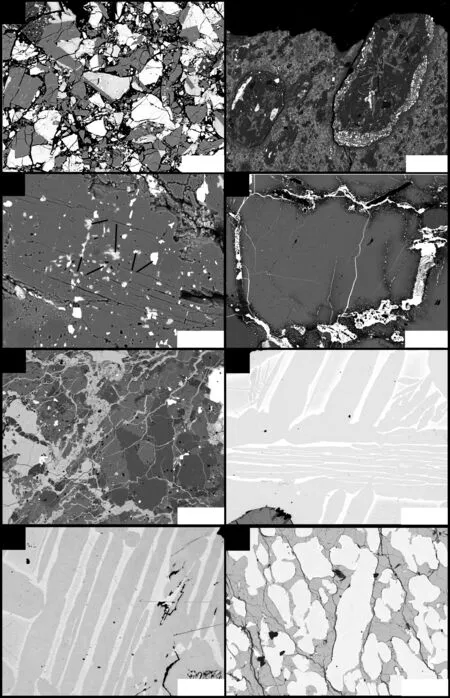
Figure 1 Back scattered electron (BSE) images of the special meteorites showing a, GRV 13001: Eucrite, composed of pyroxene (Px) and plagioclase (Plag); b, GRV 13051: CM2 carbonaceous chondrite, the ultra–fine-grained texture aqueous matrix among chondrules; c, GRV 13100: EH4 enstatite chondrite, typical sulfide assemblage of troilite (Tro), oldhamite (Old), Niningerite (Nin); d, GRV 090312: ureilite,olivine has reduction rim, carbon–rich interstitial occurs along its boundary; e, GRV 090994: mesosiderite, composed of evenly distributed silicate mineral and oxidized metal; f, GRV 090018: Iron meteorite; g, GRV 090327: Iron meteorite; h, GRV 090333: Iron meteorite. Kam(Kamacite), Tae (taenite).
The three meteorites were classified as iron meteorites:GRV 090018 (Figure 1f), GRV 090327 (Figure 1g) and GRV 090333 (Figure 1h). They are mainly composed of kamacite and taenite and all contain Widmanstätten structures, but with different widths of the kamacite bands, 100 μm in GRV 090018, 20 μm in GRV 090327 and 70 μm in GRV 090333.The Ni content in GRV 090018 kamacite and taenite varies from 11.4 wt.% to 25.2 wt.%. And GRV 090327 and GRV 090333 have Ni contents of 6.81–15.7 wt.% and 6.69–24.9 wt.%, respectively.
3.2.2 Ordinary chondrites
A total of 488 ordinary chondrites have been confirmed from the 496 meteorite samples (Table 3). The chemical groups of ordinary chondrites can be divided into the high iron group(H), low iron group (L) and low iron and low metal group(LL), which is based on the Fa content of olivine and Fs value of low calcium pyroxenes. A synthesis of the literature[13-14]shows that the standard chosen for this classification is as follows:H group = Fa16.2-20.4and Fs15.1-18.3; L group = Fa22.3-25.8and Fs18.8-22.3and LL group = Fa26.5-32.1and Fs22.6-25.9. The petrologic types can be divided into five types, from 3 to 7, based on the degree of metamorphism caused by thermal energy in their parent bodies. Type 3 is least altered and suffered the lowest degree of thermal metamorphism, i.e. the essential minerals preserve their original inhomogeneity, and are referred to as unequilibrated ordinary chondrites. The mineral compositions in various components become increasingly homogenized with increasing thermal metamorphism from Type 4 to Type 7. These are considered equilibrated ordinary chondrites.GRV 13136 cannot be judged according to the above criteria because of strong shock melting, and will be described in the next section. However, the discussion below introduces the equilibrated and unequilibrated ordinary chondrites.
A total of 477 equilibrated ordinary chondrites have been classified in this study, all of which show the general characteristics of equilibrated ordinary chondrites. The chondrule texture in these meteorites varies from well-defined to relicts only, indicating that they have suffered varyingdegrees of thermal metamorphism. Nevertheless, the essential mineral assemblages in these meteorites are olivine, low-Ca pyroxene and feldspar as well as trace minerals, e.g. Fe-Ni metal, sulfides, chromite and phosphate minerals. Of the 477 equilibrated ordinary chondrites, there are 100 Type 4 ordinary chondrites which have a relative low degree of thermal metamorphism. The chondrules usually have welldefined to readily delineated boundaries in this type, and the matrix between the chondrules is fine-grained and translucent to transparent under the light microscope, indicating mild recrystallization. In addition, secondary feldspars are small:about 10 μm.
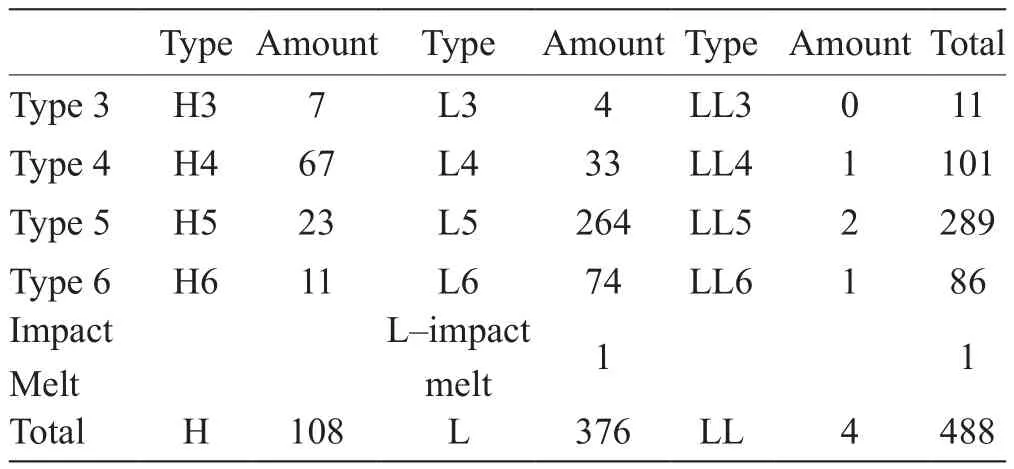
Table 3 Classification and number of ordinary chondrites in this study
A total of 289 Type 5 meteorites are classified. These have undergone a moderate degree of thermal metamorphism.This type of meteorite exhibits a chondritic texture with mainly relict chondrules, with occasionally relatively complete and round chondrules observed. Recrystallization of the matrix is much stronger than in Type 4, and secondary feldspars are much bigger: about 30 μm.
A total of 86 Type 6 meteorites are classified, and these have undergone a high degree of thermal metamorphism.Their chondrules have poorly defined boundaries, and most are fragmented. Recrystallization of their matrix is significant with the coarser-grained secondary feldspars being 80–200 μm in size. The chemical compositions of olivine and pyroxene are homogenous with the percent mean deviation(PMD) of the olivine Fa value being <5%. No Type 7 ordinary chondrites were found (Figure 2).
A total of 11 unequilibrated ordinary chondrites were classified in this study. In these meteorites, the chondritic texture is complete, and the chondrules show different textures. The majority of the chondrules are porphyritic, but there are also barred, granular, glassy and cryptocrystalline chondrules evident. The matrix between chondrules is black and opaque, and is mainly composed of glassy and finegrained silicates and metal. Based on BSE images, it is evident that these 11 meteorites have an inhomogeneous chemical composition of silicate minerals, and have olivine and pyroxene with zonation evident in gray level images.The PMD of Fa in olivine is >5% with a maximum value of 44.8% based on EPMA data. The PMD of Fa is 44.8%.Furthermore, the compositional variation of low-Ca pyroxene is greater than olivine, with PMD of Fs being >7% (maximum Fs = 57.1%). These characteristics and chemical compositions are listed in Table 4. According to the petrographic and mineral composition characteristics, the 11 unequilibrated ordinary chondrites are divided into different chemical groups as follows: GRV 090135 (H3), GRV 090306 (L3), GRV 090308 (H3), GRV 090309 (H3), GRV 090310 (H3), GRV 090313 (H3), GRV 090324 (H3), GRV 090340 (H3), GRV 091001 (L3), GRV 13008 (L3), GRV 13033 (L3).

Figure 2 Olivine Fa–Pyroxene Fs diagram of equilibrated ordinary chondrites.
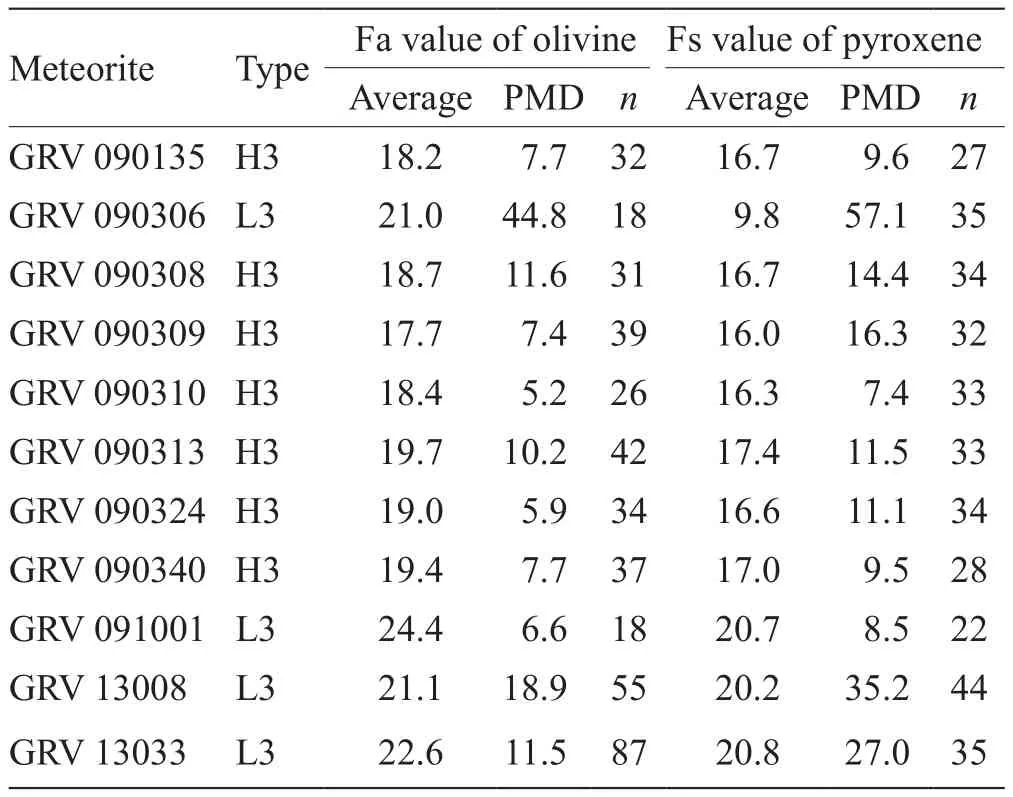
Table 4 Chemical compositions of olivine and pyroxene of unequilibrated ordinary chondrites
3.2.3 The study of shock metamorphism
Stöffler et al. devised six grades (S1–S6) of shock metamorphism for ordinary chondrites based on different shock effects visible in the silicates[11]. According to this grading system, the 488 ordinary chondrites of this study have been sub-divided into different shock grades. A total of 487 meteorites are within the S1–S5 bracket, with the majority between S1 and S3. Only one meteorite (GRV 13136) shows stronger effects (shock melt-breccia) in excess of the S5 classification. The detailed results of this classification are provided in Table 5.

Table 5 Shock metamorphic degrees of the GRV meteorites with the main shock effects described
Meteorite GRV 13136 is 0.2 g in weight, and is dark black with a partial surface covered by remnant fusion crust.No chondritic texture appears in this meteorite, but in thinsection it shows a porphyritic structure. The volumetric ratio of phenocryst to matrix is about 2:8. Phenocrysts are euhedral to subhedral olivine with an average diameter of 200 μm and show shock effects such as planar deformation fractures and undulatory extinction. Under light microscope,the matrix is translucent to opaque, and is mainly composed of glass with traces of granular silicates and metal. The granular silicates are all <50 μm in size, and include mainly low-calcium pyroxene, high-calcium pyroxene, olivine and feldspar. The opaque minerals are represented by kamacite,taenite, troilite and chromite. With the exception of oxidized metallic veins developed along fractures, the opaque minerals are dispersed in circular droplets (previously molten) between 5 μm and 30 μm in diameter. The minerals in GRV 13136 have uniform chemical compositions, with an olivine(phenocrysts and granular matrix) composition of Fa22.3±0.24,low calcium pyroxene of Fs18.7±0.3Wo1.9±0.4and high calcium pyroxene of Fs7.1±0.5Wo44.9±0.6. Based on the mineral assemblage and their compositions, GRV 13136 is an ordinary chondrite.The substantive glassy matrix and metal in the form of molten drops indicates that this sample was subjected to strong shock-induced melting. The compositional characteristics of olivine and low calcium pyroxene are consistent with the L group chemical group. In summary, GRV 13136 is an L-group shock melted meteorite which, in China, has not received significant reporting previously[15]. The discovery of GRV 13136 provides new samples with which to research inner mantle minerals.
3.2.4 Degree of weathering
After falling to Earth, meteorites are heavily influenced by terrestrial weathering. This includes the effects of water and oxygen, and the gradual decomposition and/or growth of secondary minerals. Based on metal oxidation, oxidized veins and oxidized silicate minerals in meteorites, Wlotzka sub-divided meteorites into seven grades (W0–W6) based on the degree of weathering[12]. Table 6 provides detailed information on the degree of weathering of the 488 ordinary chondrites considered in this study.
3.2.5 Characteristics of terrestrial rocks
As mentioned earlier, four samples were found to be terrestrial rocks, and not meteorites. Compared with confirmed meteorites, the four samples differ as follows:(1) they have no fusion crust or regmaglypt; (2) they have no impact metamorphic characteristics and (3) their mineral composition does not accord with existing meteorite types.A petrographic appraisal reveals that they are, respectively:garnet peridotite (GRV 13150), hematite (GRV 090239),pyroxene-peridotite (GRV 090277) and pyroxene hornstone(GRV 090352).
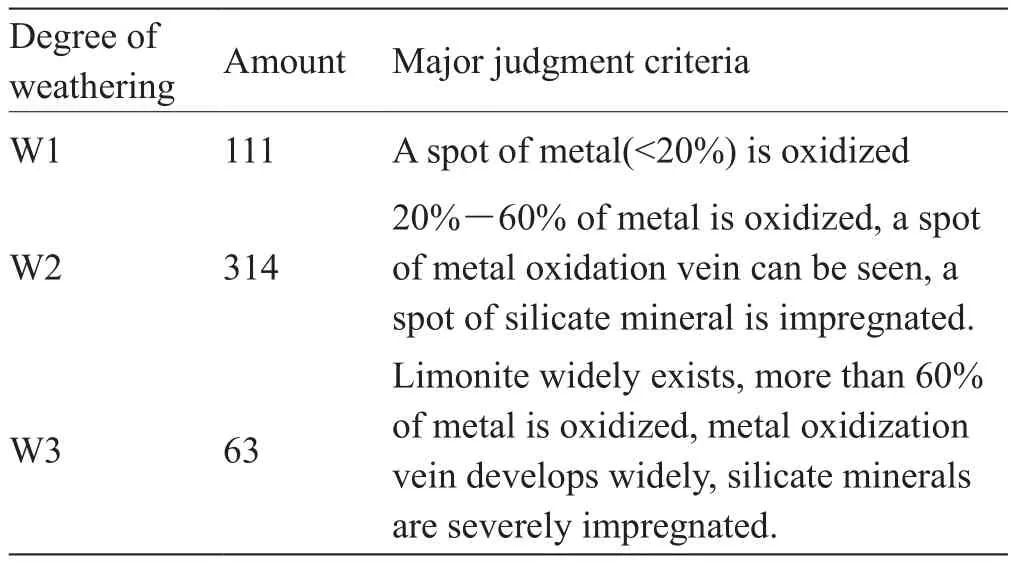
Table 6 Weathering degree[12] and description of the main judgment criteria
4 Function and significance of classification for the CAMD
4.1 Significance of meteorite classification
The primary task of meteorite classification is to distinguish meteorites from terrestrial rocks, and further sub-divide meteorite types into useful and meaningful types that reぼect not only composition, but also their petrogenetic history. The classification not only differentiates these different types and their parent bodies, but also provides better understanding of their origin and correlation with solar system history. As seen in the results of this work, classification mainly depends on petrological and mineralogical characteristics, as well as other chemical considerations, degree of weathering and impact metamorphic characteristics.
The classification method of meteorite chemical types reflects the overall effect of early solar nebula condensation, parental planetesimal aggregation, and thermal metamorphism of the parent body, hence indicating the formation and evolution history of the parent body[12]. Modern meteorite classification subdivides chondrites (undifferentiated meteorites) into 15 chemical groups, including 8 carbonaceous(CI, CM, CO, CV, CK, CR, CH, CB), 3 ordinary (H, L, LL),2 enstatite (EH, EL), and R and K chondrites.
Of the 490 chondrites discussed in this paper, there is one from the EH group, 108 from the H group, 376 from the L group, 4 from the LL group, and one from the CM group.The chemical and mineralogical composition progression from EH→H→L→LL→CM shows that their formation occurred in progressively reducing to oxidizing environments[16].The six achondrite meteorites can be subdivided into three iron meteorites, one mesosiderite, one HED meteorite and one ureilite. These meteorite types have all undergone some degree of partial melting and magmatic differentiation, and are thus referred to as differentiated meteorites. The ureilite shows a crystalline structure and has a differentiated mineral assemblage, but its trace element composition indicates that it may originate from an undifferentiated carbonaceous parent body. These dual contradictory characteristics show a lack of full magmatic differentiation, and the ureilite is therefore also referred to as a primitive achondrite[17-18]. The classification has revealed a diverse group of meteorites, which supplements very well the data already in the CAMD, and also provides rich resources for continued cosmochemical research.
4.2 Providing detailed original information for the CAMD
Field explorers and collectors can only distinguish samples visually, a challenging task in an area such as Antarctica.Undoubtedly, it can also be difficult to distinguish samples that may not be meteorites. Additionally, only rudimentary sample information is collected, such as location, date,weight and field photograph. At present, 500 samples have been classified, except for four terrestrial samples. The results, now recorded digitally, include the meteorite types,weathering grades, shock stages and photomicrographs for 496 meteorites. Additional information, which has been uploaded to BIRDS, includes chemical composition characteristics of the main minerals olivine and pyroxene,and applications that have been made to the Meteorite Nomenclature Committee for naming the meteorites.
For special meteorites, detailed petrographic features have been added, as well as some 3D digital images and backscattered electron microscope images. There is also potential for researchers to share data for furthering scientific efforts and in education. Nevertheless, analytical and other data for more than 10 000 meteorites has yet to be uploaded,a challenge that will require further funding and human resource input.
4.3 Discriminating field samples collected from Antarctica
Meteorite sample collectors can only visually distinguish them in the field based on outward appearance but, after weathering effects, the fusion crust may disappear, resulting in a smoothing of the surface and reduction or loss of obvious identifying marks. This makes meteorite identification difficult, and results in some terrestrial rocks being collected along with rarer Antarctic meteorite samples.
Except for a few of the larger samples, the majority of samples in this classification were chosen randomly from the CAMD but, on the basis of petrography and mineral chemistry, four samples were found to be terrestrial. Given that there are still about 10000 meteorites not yet classified in the CAMD, it should be expected that a similar, small percentage, will prove not to be meteorites. This is certainly one of the primary reasons for continuing the classification research.
4.4 Providing more data and information for meteorite science
As early as the 19th century, scientists regarded meteorites as precious samples of the early solar nebula, and conducted much research into their composition and origin[19]. Chinese research on meteorites started late. Only in 1976, after the Jilin chondrite meteorite fell in China, did Chinese researchers begin multidisciplinary integrated studies into meteorites[20]. From an educational perspective, the average Chinese civilian also had relatively limited awareness of meteorites and their significance. Finally, a general lack of standard management of meteorite collections led to increasing awareness of the need for further scientific endeavors with regard to meteorites.
Basic classification has provided a large number of rough stone photographs and internal structure photomicrographs for helping researchers to understand the appearance and basic features of meteorites. Analytical data gleaned from the different types of meteorites can also expand the views of the researchers and popularize general knowledge about meteorites. Since 2006, the platform of Antarctic meteorites has been available for the public and for use in scientific research, education and outreach in accordance with the “Regulation of Chinese Antarctic Meteorites Management and Application”. Based on these purposes, interested persons and institutions can apply to work with the Antarctic meteorite collection, as has been the case already in many scientific popularization exhibitions.In summary, the classification research of the Antarctic meteorites not only provides basic information for further study in China, but may increase researcher curiosity for meteorites and highlight the significance and future inぼuence of the Antarctic meteorite collection.
5 Conclusions
Classification of 500 Antarctic meteorites has been completed, with 488 classifying as ordinary chondrites, one eucrite, one ureilite, one CM2 carbonaceous chondrite, one EH4 enstatite chondrite, one mesosiderite and three iron meteorites. Four samples were found to be of terrestrial origin.
Classification not only confirmed their types, but also provided petrological and mineralogical characteristics, shock metamorphic characteristics, degree of weathering and other detailed information. The revelation of these classification results will hopefully popularize meteorites in science and education, advance the development of Antarctic meteorite research and promote cosmochemical research in China.
AcknowledgementsThis study was supported by the National Natural Science Fund of China (Grant no. 41173077), the Scientific Research Project of Guangxi Colleges (Grant no. KY2015LX119), the National Science and Technology Infrastructure Platform Project (Grant no. 2005DKA21406)and the Key Laboratory of Geological Fluid and Geological Process at Universities of Guangxi Province, The Antarctic meteorite samples were provided by the AMD at PRIC. The preliminary treatment of samples was undertaken with the help of Ms. Zhang Lihua from PRIC. We thank two anonymous reviewers for their constructive suggestions.
1 Miao B K, Lin Y T, Wang D D, et al. Progress of Antarctic meteorite collection in China (2000-2010). Bull Mineral Petrol Geochem, 2012,31(6): 565–574 (in Chinese)
2 Miao B K, Ouyang Z Y, Lin Y T, et al. The retrospect and prospect on Antarctic meteorite researches in China. Geol Sci Technol Inform,2008, 27(1): 13–19, 30 (in Chinese)
3 Miao B K, Wang D D. Classification of meteorites from the Grove mountains and its significance. Chin J Polar Res, 2008, 20(2): 95–104(in Chinese)
4 Lin Y T, Wang D D, Ouyang Z Y. Recent advances in Antarctic meteorite research in China. Chin J Polar Res, 2008, 20(2): 81–94 (in Chinese)
5 Cheng W F, Zhang J, Xia M Y, et al. System design and implementation of a Resource-Sharing Platform for Polar Samples.Chin J Polar Res, 2013, 25(2): 185–196 (in Chinese)
6 Chen J, Liu X H, Ju Y T, et al. The classifitacion of the first four Antarctic meteorites in China. Acta Petrol Sin, 2001, 17(2): 314–320(in Chinese)
7 Dai D Q, Lin Y T, Miao B K, et al. Ca-, Al-rich inclusions in three new carbonaceous chondrites from the Grove Mountains, Antarctica:new evidence for a similar origin of the objects in various groups of chondrites. Acta Geol Sin, 2004, 78(5): 1042–1051
8 Lu R, Miao B K, Wang G Q, , et al. Classification of 24 new ordinary chondrites from the Grove Mountains, Antarctica. Acta Geol Sin,2004, 78(5): 1052–1059
9 Weisberg M K, McCoy T J, Krot A N, et al. Systematics and evaluation of meteorite classification//Lauretta D S, McSween Jr H Y. Meteorites and the early solar systemⅡ. Tucson: University of Arizona Press, 2006: 19–52
10 Wang D D, Miao B K, Lin Y T. Mineralogic-Petrologic characteristic of meteorites and their classification. Chin J Polar Res, 2005, 17(1):45–74 (in Chinese)
11 Stöffler D, Keil K, Scott E R D. Shock metamorphism of ordinary chondrites. Geochim Cosmochim Acta, 1991, 55(12): 3845–3867
12 Wlotzka F. A weathering scale for the ordinary chondrites.Meteoritics, 1993, 28(3): 460
13 Dodd R T. Meteorites-A petrologic-chemical synthesis//Dodd R T.Research supported by the U.S. Air Force, State University of New York, NSF, and max-Planck-gesellschaft. Cambridge, England, New York: Cambridge University Press, 1981: 377
14 Van Schmus W R, Wood J A. A chemical-petrologic classification for the chondritic meteorites. Geochim Cosmochim Acta, 1967, 31(5):747
15 Zhang G L, Li C L, Liu J Z, et al. Petrology-mineralogy of GRV 052483 from the Grove mountains, Antarctica: an L-chondrite impactmelt rock. Chin J Polar Res, 2008, 20(2): 201–207 (in Chinese)
16 Wang D D. Introduction of Chinese Meteorites. Beijing: Science Press, 1993(in Chinese)
17 Wang D D, Miao B K. Mineralogic-petrologic characteristics of Ureilites and their history of cosmic-ray exposure ages. Chin J Polar Res, 2007, 19(2): 139–150 (in Chinese)
18 Miao B K, Lin Y T, Wang G Q, et al. The petrology-mineralogy of the new discovered Ureilite from the Grove mountains, Antarctica. Progr Nat Sci, 2008, 18(3): 431-439 (in Chinese).
19 Ouyang Z Y. Cosmochemistry. Beijing: Science Press, 1988
20 Huang W, Xie Y, Pan J. Transparent minerals in the Jilin Meteorite.Geochimica, 1978,1: 25-34, 85-86
杂志排行
Advances in Polar Science的其它文章
- Norwegian contributions to Arctic environmental sciences from the 1880s to the third International Polar Year
- Biodiversity and phylogenetic analysis of the gut microbiome of Euphausia superba Dana from the Rose Sea of the Antarctic Ocean
- Structure and seasonal variability of fronts in the Southeast Indian Ocean along sections from Fremantle, Australia to Antarctic Zhongshan Station
- Outreach channels for polar science: an expedition to Kerguelen Islands as a case study
- Potential methane production rates and its carbon isotopic composition from ornithogenic tundra soils in coastal Antarctic
- Expression analysis of heat-shock protein gene Hsp845 in the Antarctic psychrotrophic bacterium Psychrobacter sp. G under temperature and salinity stress
